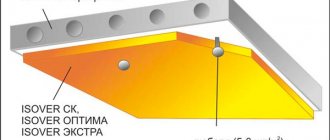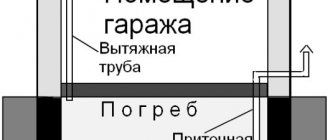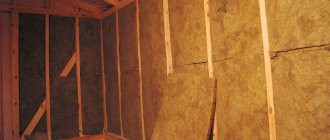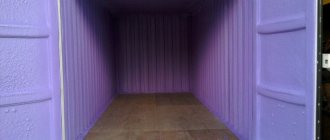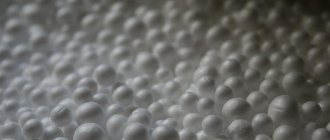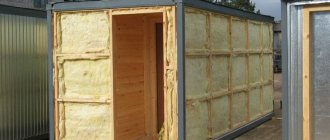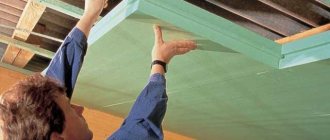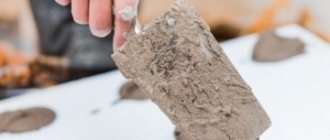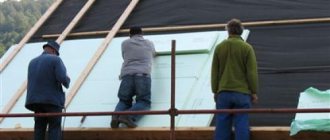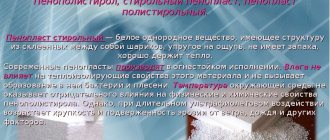Microclimate in the cellar
Even in cases where the cellar is not located under a country house, but separately from it, insulation must be carried out. Otherwise, the building will not serve you for even several years, gradually collapsing from the effects of surrounding dampness and temperature changes.
In addition, the temperature in the cellar that is optimal for storing food must be maintained year-round (about 2-4 degrees Celsius). High-quality installation of thermal insulation materials will allow you to maintain such a microclimate both in summer and winter. In the summer months, a layer of insulation will not allow warm air to penetrate into the room through the ceiling, and in winter it will protect against frost.
Without insulation and maintaining a constant temperature, moisture will gradually accumulate in the cellar, which will begin to condense on the ceiling and wall surfaces. In addition, when arranging thermal insulation, it is very important to provide for the presence of high-quality waterproofing. After all, even the best insulation and a powerful ventilation system will not be able to provide an optimal microclimate inside the cellar if groundwater systematically enters it.
To create the right conditions for storing food in the cellar, all work must be carried out comprehensively: thermal insulation, waterproofing and installation of a ventilation system.
Features of insulation of various parts of the cellar
First you need to decide which insulation for the cellar to choose. This depends on the heat-insulated surface and the specifics of the material used. We will look at the most popular options, and you will have to make the final choice.
External thermal insulation
Insulation of the outside of the building is relevant in cases where the cellar is located under a garage, in a barn or near the outer walls of the house, and also if it is located separately. In cases where the cellar is located under the house several meters from its outer walls, this operation does not need to be carried out.
At this stage, the following features can be distinguished:
- It is best to carry out work during the construction stage, when there is space . Otherwise, you will have to clear the entire foundation, and in some cases this is almost impossible to do.
- The walls must be waterproofed . The best option is modern roll materials and liquid rubber. These coatings last for decades, unlike bitumen and roofing felt.
- If there are large gaps, it is best to seal them with polyurethane foam ; it reliably insulates and does not collapse over a long period of time.
- Next, foam plastic or other sheet heat-insulating material is attached . The easiest way to glue it is with polyurethane foam or a special composition. You can also use bitumen mastic - when it dries, it also provides high fastening strength.
In the photo - thermal insulation material for external insulation is attached to a pre-waterproofed surface
Advice! If high quality work is important to you, it is better to use extruded polystyrene foam. This material is much stronger than ordinary foam plastic, it has higher thermal insulation properties, and thanks to the grooves at the ends, the joints are very reliable.
- To ensure maximum efficiency of the thermal insulation layer on the street, it is necessary to make a blind area along the wall to protect the basement walls from moisture.
The blind area will reliably protect the layer of external insulation and significantly extend its service life
Floor insulation
This is also an important point in the construction of a cellar. Many people believe that gender does not require special attention, but this is not true. In order for your floor to be reliable, it should be thermally and waterproofed. There are several ways to do this.
Insulation using expanded clay:
- The base is leveled, which needs to be covered with roofing felt or filled with bitumen, and a waterproofing agent is glued to it.
- Next, expanded clay of fractions from 5 to 20 mm is poured. The layer of material should be from 10 to 25 cm. A concrete screed with reinforcement is poured on top of the material, the thickness of which depends on the expected load on the floor. After it hardens, you can carry out additional waterproofing of the surface.
Expanded clay is an excellent material for floor insulation
It is worth noting that expanded clay is a very light material, which simplifies the process of working with it. In addition, the price for this material is quite affordable.
You can insulate the floor using sand and crushed stone:
- The site is prepared and leveled, after which 15-20 cm of fine crushed stone is poured onto it. Then a layer of sand 5-10 cm thick is poured.
- The pillow is compacted and waterproofed; this can be done using roofing felt or construction film.
- Next, a reinforcing belt is installed and concrete is poured. If groundwater is located close to the surface, you can waterproof the poured surface and make a 5 cm thick screed on top. This will provide additional protection.
A reinforcement structure is installed on the gravel-sand cushion and concrete is poured
The third method is foam insulation:
- A sand or gravel cushion is installed, which is covered with a waterproofing material.
- Grade 35 foam is laid on top.
- Next, a screed is poured, which, if necessary, can be reinforced to increase strength.
But this method is less common, since the floor can be perfectly insulated in simpler ways.
Wall insulation
We have looked at how to carry out work on the outside, now we will look at how to insulate the cellar from the inside.
The best option is polystyrene foam due to ease of installation and low price. With its help, you can easily carry out insulation with your own hands; you do not need the help of specialists or instructions - everything is very simple.
The walls must first be prepared - they must be smooth, all defects must be repaired with cement mortar. If there is a danger of flooding, it is better to treat the walls with a penetrating solution; at the moment this is the best protection of the premises from moisture.
The easiest way to glue sheets of insulation is to glue them, after which the surface is covered with reinforcing mesh and plastered.
Polystyrene foam provides excellent thermal insulation
It is worth noting that when insulating external walls with polystyrene foam 10 cm thick or more, internal insulation can be omitted.
Another option is to press guide bars along the walls, after which foam plastic is inserted between the bars, and the surface is covered with wood or moisture-resistant sheets.
Many developers prefer to use mineral wool; its installation process is no different from polystyrene foam. If the insulation will be carried out under plaster, solid insulation is used, if under the bars - soft mats or rolled material.
Another option is insulation with sprayed polyurethane foam. At the moment this is the most reliable and durable insulation. It has no seams, is resistant to moisture and has high thermal insulation properties. But the price of this solution is much higher than others.
Spraying is done between the bars, after which the surface is sewn up - everything is very simple
Ceiling insulation
As a rule, the main problems with the microclimate in the basement are associated precisely with poor-quality insulation of the upper partition. Therefore, it is definitely worth doing.
There are several basic options for how to insulate a cellar from above. Let's look at each of them.
You can use polystyrene foam: fill the slats, insert insulation between them and seal all the seams with polyurethane foam.
Polystyrene foam can be used on both walls and ceilings
You can fill the sheathing at a distance of 30 cm from the ceiling with 40 cm cells, or weld it from metal. Sealed plastic bags with moss, straw and other natural materials are stuffed into the created space.
You can use polyurethane foam spraying, but this will cost a significant amount.
Door insulation
Many people, when insulating a cellar, forget that a significant part of the coolness escapes through a poor-quality door. It is best to make a vestibule with two doors. But it’s still better to additionally insulate the inner fabric. The easiest way is to cover it with foam plastic - this is a simple and effective way of insulation.
You can simply glue the foam to the door
Do-it-yourself cellar insulation
Before building a cellar, you need to decide on the thermal insulation material that is best suited for your situation. One of the most accessible and inexpensive heat insulators, as already mentioned, is ordinary polystyrene foam.
Today there are many technologies according to which it is possible to make high-quality insulation of the cellar.
Fastening foam plastic boards using dowels.
If the basement is just under construction and it is possible to insulate it from the outside, this should be done. Since when installing heat-insulating material outside the building, it is possible to completely eliminate possible freezing of the basement in the winter months. However, if the room has already been built, then thermal insulation work in most cases can only be carried out from the inside. The floor, ceiling and walls should be insulated.
It is worth noting that with internal thermal insulation, condensation will form at the junctions of two materials (between the insulation and the wall), which will negatively affect the building material. Therefore, the heat insulator must be resistant to moisture.
It is very important to provide good waterproofing for the cellar walls from precipitation and groundwater. This approach will protect the insulation from its gradual destruction during operation.
When insulating the basement with foam plastic, many problems associated with the operation of this room are solved. Polystyrene foam is also excellent for cellars as the main insulation material.
How and with what is basement insulation done?
Not only the walls, floor and ceiling of a building need thermal insulation. If the building has a basement, it is important to pay attention to its insulation, which will solve a number of problems.
Why and how to insulate a basement will be discussed below.
1 Why insulate the cellar?
Often, home owners prefer not to insulate the cellar to save money during construction. Because of this, the concrete base is in constant contact with the ground. In winter, the ground freezes, causing the concrete to freeze as well.
.
In addition, the soil contains moisture: after rains, it can linger in the ground for more than one or two days. In addition to precipitation, the soil itself in the area may be wet, and then the foundation of a private house will be constantly exposed to moisture.
As a consequence, this leads to the following problems:
the destruction of the concrete itself is accelerated (due to the fact that in winter moisture penetrates into the slightest cracks, cracks, recesses, and freezes and thaws there; when freezing, the liquid expands, as a result, the cracks expand);
Article on the topic: Walls in a private house are damp, what to do
a low temperature is established in the basement of a private house (concrete itself retains heat very poorly, even with a thickness of several tens of centimeters);
high humidity is maintained in the basement of the house, which leads to the appearance of fungus and mold;
the air in the rooms on the first floor of the house becomes cold, and if the humidity in the basement is very high, then mold can also appear in the rooms.
Condensation on the basement ceiling without thermal insulation
Due to the problems mentioned above, the usable area at the bottom of the house cannot be fully used. Dampness and mold will cause things (whether furniture or food) to quickly deteriorate. And for humans, too humid air, which contains fungal microspores, is also harmful: it can lead to allergies and respiratory diseases.
2 Where and what to insulate?
Partial thermal and waterproofing of the basement does not solve the problem: all walls and floors need to be protected from moisture and cold. Insulation of the basement ceiling (the floor between the cellar and the first floor of the house) can be done as needed to achieve the maximum heat retention effect.
Also, a home owner who does not know how to insulate a basement may have a question about how exactly to do it: from the inside or the outside?
The only correct answer will be to insulate
the outside
: only in this case will it be possible to create the correct “barrier” against the cold. Otherwise - if only the basement is insulated from the inside - moisture and cold will still have a negative effect on the concrete. In addition, mold and mildew can still appear, but this will happen inside, between the basement wall and the insulation.
Concrete temperature during external and internal insulation of basement walls
Internal insulation is necessary as needed. If the owner wants to achieve maximum heat retention inside, then work can be done inside. If you just want to avoid dampness and mold, and also protect the building itself from premature destruction, it is enough to insulate the basement from the outside.
3 About the choice of material
Since the main “threat” to the structure will be moisture, it is necessary to choose materials that are resistant to it. For this reason, mineral wool insulators, which can become saturated with moisture and crumble, are no longer needed.
In order to insulate the basement walls from the outside (this is the main type of work), it is best to use:
polystyrene foam or extruded polystyrene foam (thermal conductivity coefficient - 0.035-0.04 and 0.03 W/mK);
expanded clay (thermal conductivity coefficient - 0.12 W/mK for an average density of 400 kg/m³);
sprayed polyurethane foam (thermal conductivity - 0.03-0.035 W/mK).
Insulation of basement walls with polystyrene foam from the outside
These materials are not the only insulators, but they are the ones most often used and are best suited for the job.
In addition to insulation, the basement of the house will also require external waterproofing. To create a moisture-proof layer the following can be used:
moisture-resistant additives in concrete (if insulation of a cellar in a garage or house is planned at the stage of its construction);
It will be optimal if waterproofing is performed by combining the first option with any of the remaining ones.
Preparatory work
If the cellar is located under your house, then all work on its insulation must be provided for at the design stage. In addition, if the thermal insulation layer is laid during construction, it will be possible to immediately combine it with waterproofing and drainage.
Preparatory work for installing cellar insulation has the following features:
- Before installing the insulation, it is necessary to ensure that the walls are perfectly level.
- After leveling the surface, it should be treated with special antiseptic compounds.
- Immediately after installing the thermal insulation layer inside the cellar, the humidity level will increase, so you must immediately provide for the presence of a high-quality ventilation system.
When installing a thermal insulation layer for a cellar made of foam plastic, it is important to follow the correct order of work.
Ceiling insulation
Cellar insulation includes work on thermal insulation of walls, ceiling and floor. It is imperative to insulate the ceiling, paying special attention to this work.
Foam insulated ceiling.
The work is carried out using the following technology:
- The first step is to eliminate all cracks, seams and crevices on the surface. If you use dowels to fasten the heat-insulating material, then they must also be insulated with insulation, because cold will definitely penetrate into the room through them, although not in significant quantities.
- At the next stage, it will be necessary to install a vapor barrier material on the ceiling so that condensation does not form in large quantities during operation of the cellar. Penofol can be used as a vapor barrier material. This material, among other things, will also create an additional thermal insulation layer, and of quite high quality.
- Next, the hangers necessary for fastening the sheathing profiles are installed. The distance between the hangers should be equal to the width of the slabs of heat-insulating material. Then, using self-tapping screws, the longitudinal profiles are fixed to the hangers.
- Thermal insulation material is laid between the profiles. In our case, foam boards. It is also recommended to insulate the joints using construction foam or other material.
- It is recommended to install another layer of vapor barrier on top of the thermal insulation layer. It is important to maintain a distance of approximately 40-50 mm between the heat insulator and the vapor barrier. This gap will allow for micro-ventilation between the materials.
After all the work is completed, the height of the cellar will be slightly reduced, but this must be sacrificed in order to obtain an optimal indoor microclimate. Finally, any materials intended for finishing, if any, can be installed on the vapor barrier layer.
Floor insulation
It is unlikely that anyone will agree to install a heated floor system in a utility cellar or basement, so you need to consider more traditional options for carrying out insulation work.
Insulation of the cellar floor can be carried out as follows:
- A high-quality waterproofing layer is laid on the pre-leveled surface of the subfloor.
- Next, a layer of insulation about 4-6 cm thick is installed (no longer required).
- Finally, a layer of penophenol is laid.
It is best to lay reinforced screed on the thermal insulation layers.
Wall insulation
The feasibility of insulating cellar walls is beyond doubt. It is from the surrounding soil that the cold will penetrate into the cellar in winter. Therefore, it is quite difficult to do without a high-quality thermal insulation layer on the walls. We also use foam plastic as insulation.
Insulation of room walls with foam plastic.
The work is carried out in the following order:
- The first layer is a waterproofing material, which will prevent moisture from entering the room and onto the foam. Before gluing the material, you need to level the surface.
- Foam boards are mounted on the waterproofing layer. To secure them, you can use any high-quality adhesives.
- After the entire surface of the cellar wall is finished with foam plastic slabs, it needs to be covered with a thin cement screed. If you are concerned about the strength of the screed, then it is recommended to use additional reinforcement when constructing it. To create a concrete layer, you need to purchase cement grade M 100.
- The cellar is a room with high humidity, so it is best to lay an additional waterproofing layer on the wall.
- The finished surface can be covered with tiles or any other finishing material.
All joints that will be formed must be sealed with special polyurethane foam. Then you will have a perfectly insulated cellar made of polystyrene foam.
The procedure for insulation work
To insulate outside walls, special slab insulation materials are usually used, which are easy to install. The slabs are fixed to the waterproofing layer using adhesive mixtures or mastics. Treating the entire surface of the insulation board with mastic reduces the risk of the insulation shifting when the ground moves.
Related article: The best way to sand walls after puttying
It is recommended to carry out insulation immediately during the construction of the house.
Cold mastic must be applied to the surface of the slab, then pressed against the wall and held until the adhesive hardens (usually 30-40 seconds).
The laying of thermal insulation slabs should begin from the bottom (strictly along the perimeter); the slabs can protrude 30-40 cm above the ground.
It is important that the insulation boards are of the same thickness. In addition, it is necessary to ensure that they are tightly adjacent to each other. It is recommended to immediately seal all resulting voids with construction foam. In the future, the slabs will be securely supported by a layer of soil. The main thing is that they do not move apart or move.
Insulation of basement walls, as noted above, should be carried out during the construction phase of the building. If for some reason this was not done, then it is better to insulate the basement yourself only from the inside. External insulation in a built house can only be done efficiently by professionals. It is not recommended to do such work yourself without the appropriate skills due to the high risk of weakening the foundation and walls of the building.
